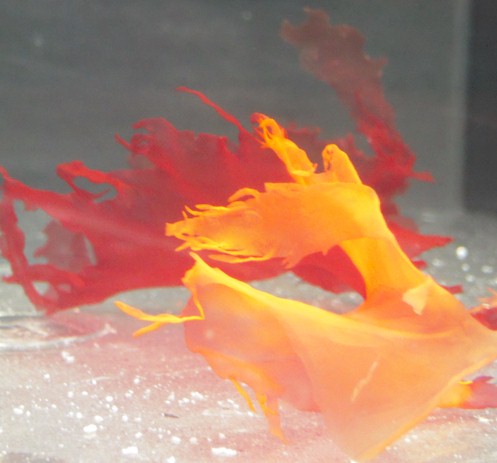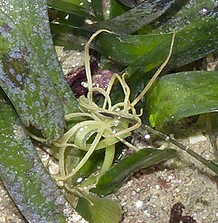|
 When
marine plants release reproductive spores, or gametes, the result is
that the plant dies. This is the cycle that often occurs with species
of Caulerpa in the aquarium when conditions are favorable
for reproduction. When Caulerpa begin the process, they often turn
yellow with little white spots appearing on the fronds or blades.
A white milky substance is then released into the aquarium water.
This secretion is composed of the gametes and the cell tissue of
the algae. Clear tissue in most species is usually not
associated with reproduction, but rather a sign of nutrient deficiency. When
marine plants release reproductive spores, or gametes, the result is
that the plant dies. This is the cycle that often occurs with species
of Caulerpa in the aquarium when conditions are favorable
for reproduction. When Caulerpa begin the process, they often turn
yellow with little white spots appearing on the fronds or blades.
A white milky substance is then released into the aquarium water.
This secretion is composed of the gametes and the cell tissue of
the algae. Clear tissue in most species is usually not
associated with reproduction, but rather a sign of nutrient deficiency.
What
causes reproduction in marine algae? Marine macro algae reproduce when their
environment changes, or when their "biological clock"
say it's time. Some of the conditions known to induce a sexual
event in nature are: spring tides, lunar phases, temperature and photo
period. Some species of algae are even known to release pheromones or organic
chemicals to attract male gametes. Several species of marine algae
however, are not
affected by photo period alone and can reproduce in both light or
darkness. In the aquarium the conditions are artificially
maintained, so care must be taken to limit any sudden change in
water quality that can induce a sexual event. Species of Caulerpa
are known to not release
reproductive spores if kept under
constant illumination. While this may be true, its growth is
typically stunted and the algae cease from productively removing nutrients
as the process of
photosynthesis is slowed. This is known as the 24/7 lighting cycle
and is typically employed by aquarists culturing Caulerpa in the
refugium.
Controlling
growth
Germinated
gametes or spores attach themselves to a surface such as rocks or substrate and then begin their growth. Most live rock, imported or
aquacultured, are covered in both fertile and unfertile algae
spores. This
is why,
after several weeks or months of favorable conditions in the
aquarium, up sprouts a new plant, seemingly out of nowhere. It
also explains why undesirable algae such as micro algae and
invasive turf algae can quickly appear and take over the live rock
and eventually an entire system. The proper cycling of live
rock is crucial to remove many of the undesirable algae that may
reside upon the surface of the rock.
Control
of both micro and macro algae growth is usually accomplished by
limiting excess nutrients in the aquarium by using the correct
spectrum bulbs and maintaining the temperature of a system. The turbidity
of the aquarium environment will also affect growth in
marine macro algae. Species that grow in protected habitats will
not grow at the same rate or share the same characteristics if
introduced to strong currents in the aquarium. This is evident
with many species of Caulerpa, especially C. Mexicana. It will
remain short and compact in strong current, while growing tall and
wide in a sheltered environment. Overall however, marine micro and
macro algae are very resilient and will adapt to almost any
artificial conditions including current, lighting, temp, salinity
and ph. Another limiting factor of growth in marine algae in the
aquarium is the competition for nutrients and sunlight between
species. When conditions are favorable for rapid growth,
eventually one species will try to dominate the landscape and
"choke out" other species or colonies. This can be
avoided by diligently pruning the aquascape so that no colony
intrudes or outgrows its biomass or given space.
 Reproduction
in sea grasses Reproduction
in sea grasses
The
marine flowering plants (angiosperms) reproduce by both sexual or
asexual (vegetative) methods. In sexual reproduction, the plants
produce flowers and transfer pollen from the male flower to the
ovary of the female flower. Most
sea grass species produce flowers of a single sex on each
individual, so there are separate male and female plants. Some
species only reproduce through vegetative means. Vegetative
reproduction is a type of asexual reproduction for plants in
which new plants are formed without the production of seeds or
spores. In asexual reproduction, the new plants are formed by the
rhizome which serves as an organ of vegetative reproduction. Shown
to the left is a picture of a newly formed flower on a species of
Thalassia. Flowering plants are rarely seen in the aquarium and
are unlikely to reproduce by seed in captivity as conditions are
not favorable. Most of the occurrences in the aquarium are from
sea grasses collected just before the flowering stage.
|